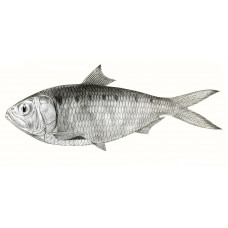Latin name
Hilsa kelee
Other names
Fivespot herring, razorbelly.
Identification
Hilsa kelee is now considered the only species in the genus Hilsa, although other species were previously included in this genus. Body rather deep and compressed, abdomen with distinct shield keel; upper part of head with numerous frontoparietal grooves; upper jaw with median notch; gill rays from 100 to 175 mm long, gill rays on inner arches distinctly twisted; outer row of gill rays on first arch not exceeding half the length of the gill; row of small triangular scales above pectoral fin sinus; posterior part of body scales perforated.
Features of fish fins
Dorsal spines (total): 0; Dorsal soft rays (total): 16-19; Anal spines: 0; Anal soft rays: 17-23.
Fish colouring
Have a black spot behind the gill cover, usually followed by up to 10 spots along the flank.
Distribution
Indo-West Pacific: probably all coasts of the Indian Ocean, from the Gulf of Oman and the Gulf of Aden south to Durban and Madagascar, through the Bay of Bengal, the Gulf of Thailand, the Java Sea, and north to Hong Kong and east to Papua New Guinea and possibly beyond.
Habitat
Marine tropical pelagic-neritic species. Depth range from 10 to 150 meters.
Size
Some individuals can reach 35 centimeters, but most are around 16.5 centimeters.
Behavior
Passage fish. They live in coastal waters, but enter estuaries and can tolerate fairly low salinity.
Food and feeding habits
They feed mainly on phytoplankton, diatoms, dinoflagellates, paddlefish and crustacean larvae, shrimp, amphipods and polychaetes.
Reproduction
They are seen spawning at the mouth of the Godavari River around February.
Fishing
Have commercial value. Sometimes used as bait.
Relationship with a person
It is sold fresh, dried, dried salted and cooked.
| Classification | |
| Phylum | Chordata |
| Class | Actinopterygii |
| Squad | Clupeiformes |
| Family | Dorosomatidae |
| Genus | Hilsa |
| Species | H. kelee |
| Features | |
| Conservation status | Least Concern |
| Habitat | Pelagic |
| Life span, years | No information |
| Maximum body weight, kg | No information |
| Maximum length, cm | 35 |
| Sailing speed, m/s | No information |
| Threat to people | Edible |
| Way of eating | Planktonophage |
Kelee shad
Tags: kelee shad

